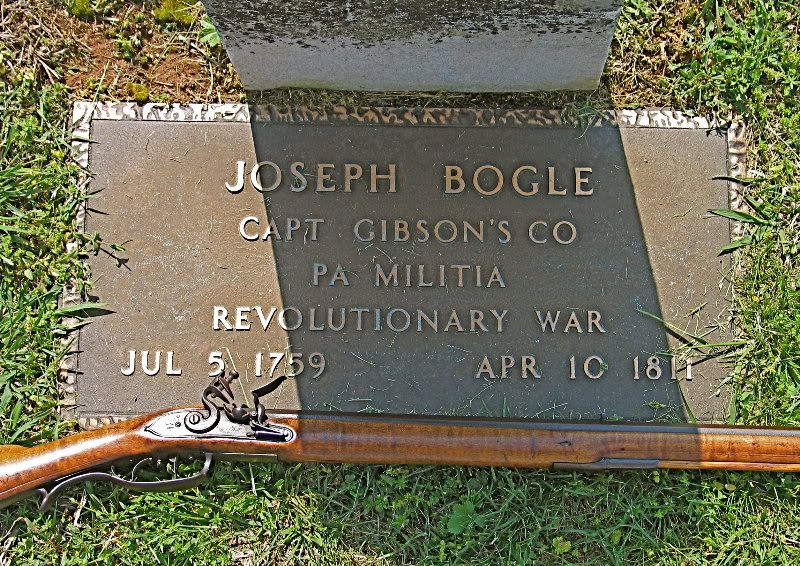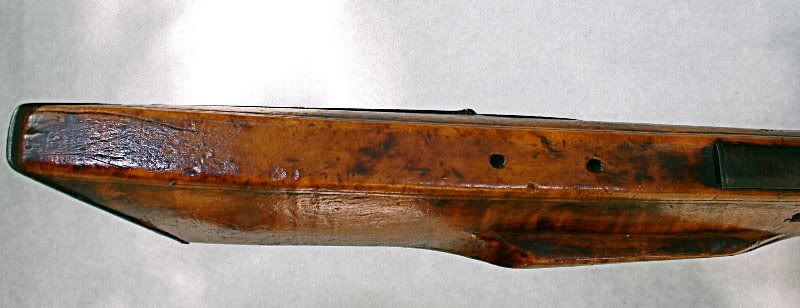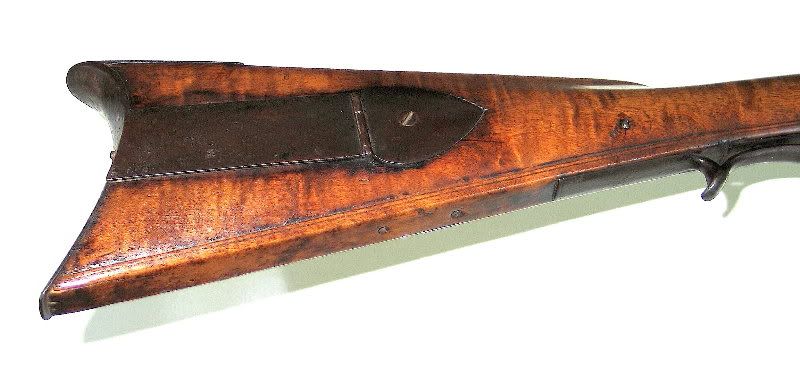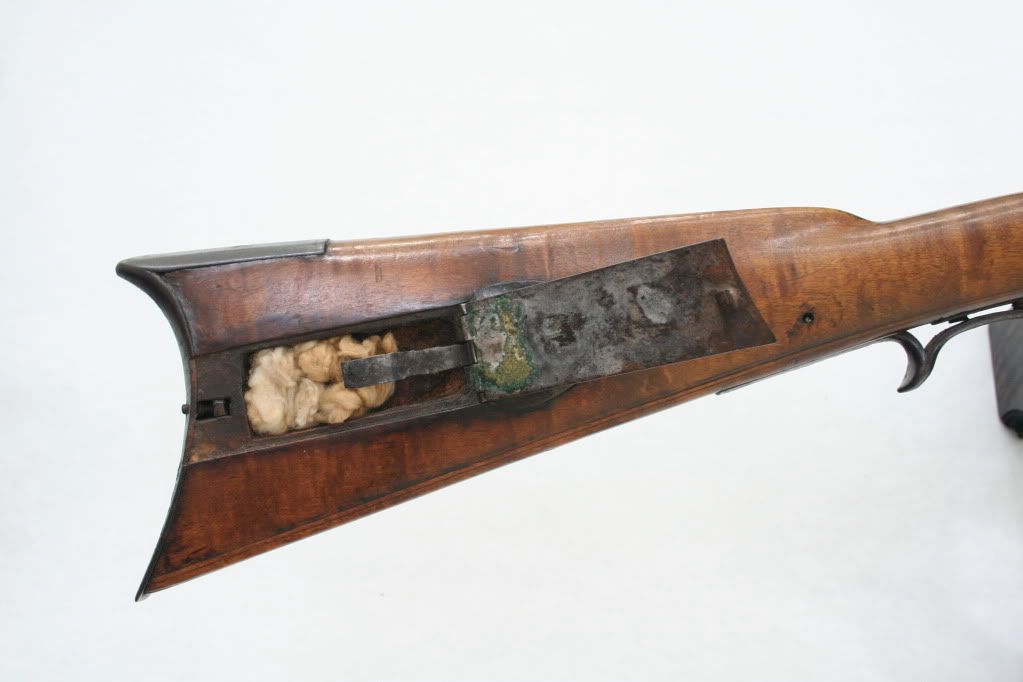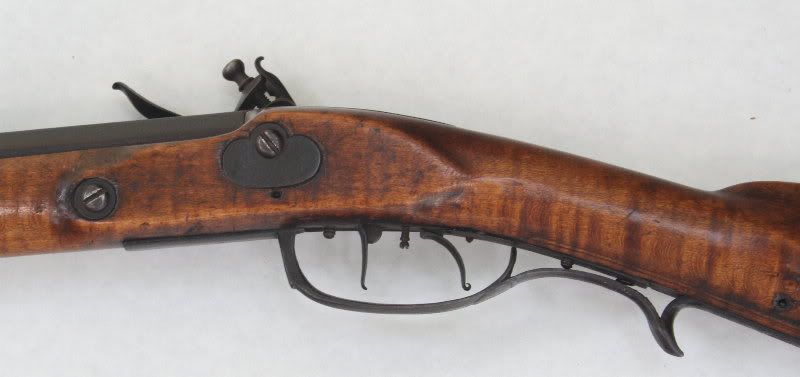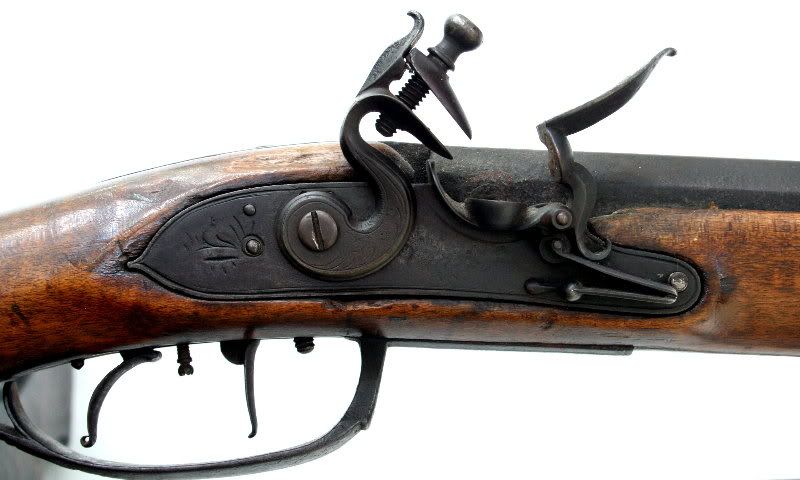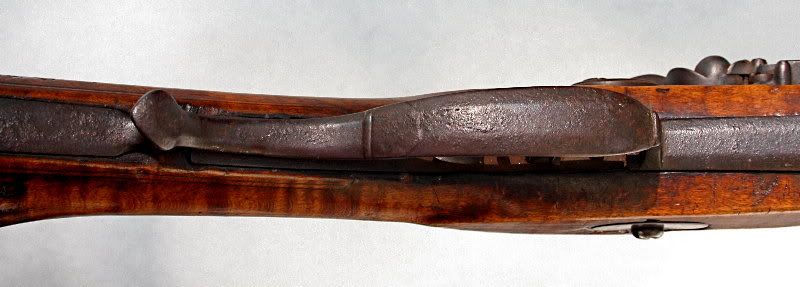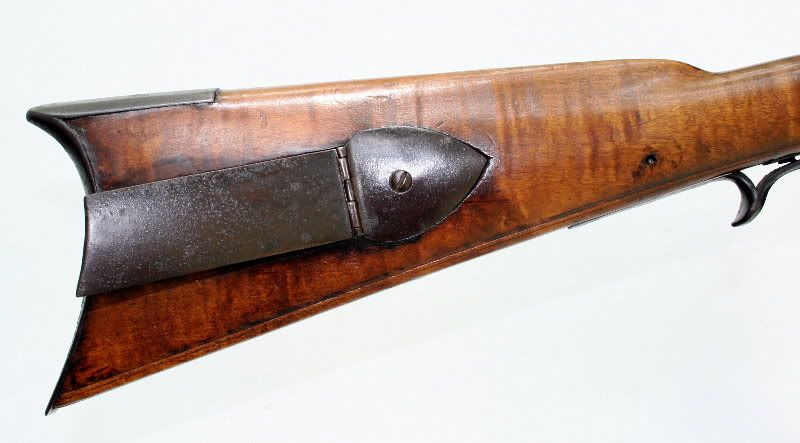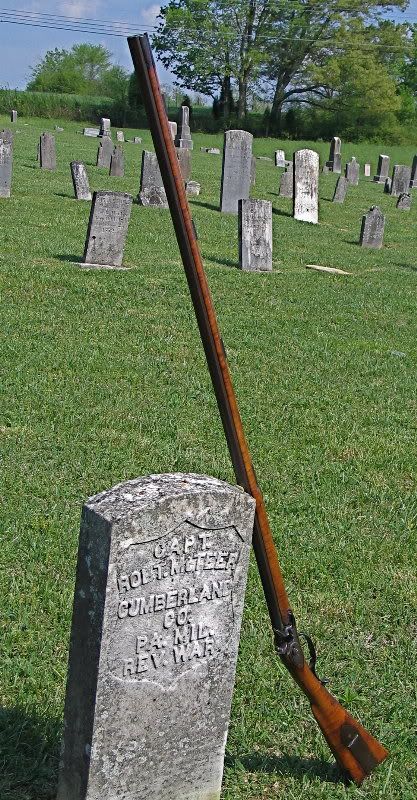A classic Southern rifle about which much is known. The maker, Jo Bogel, his history and the linage of the owner ship in the McTeer faily of Tennessee is detailed.
THE BOGLE RIFLE- AN EARLY TENNESSEE PIONEERWayne T. Elliott
I. Introduction.
Some years ago, Tom Patton, a Tennessee lawyer, historian and long-time Kentucky rifle collector, acquired two early longrifles from an old Tennessee family. This article will consider the earlier of those rifles. In doing so, the writer will draw, with great appreciation, much from Tom Patton’s excellent research.
The old McTeer home place from which Tom acquired the rifle was built in the early 1800s some twelve miles northeast of Maryville, Tennessee. McTeer family tradition is that the rifle originally belonged to Robert Montgomery McTeer. Thus began a quest for information about McTeer and the “Jos Bogle” who made this fine old rifle. A fascinating story unfolded.
II. The Rifle.
This handsome rifle has double-set triggers, with a Virginia lifting style to the rear trigger, an iron trigger guard, four octagon iron thimbles, and four iron keys passing through iron escutcheons. The original flintlock is in place and is secured with two lockbolts with oval and round iron side washers. The iron patchbox is two pieces with a spade shaped finial, and a release in the center of the buttplate. The ramrod is old and has an iron tip. The tang is 3” with a single screw threading into the trigger plate. The stock appears to be birdseye birch.
The overall architecture of the rifle reflects a strong lower Valley of Virginia influence. A silver plate on the top barrel flat is signed “Jos Bogle” in script. At the time the rifle was collected from the original family, the sear was broken and it is likely that break helped to preserve the rifle in untouched, unaltered condition because the rifle apparently was retired from use before it was misused or converted to percussion.
III. The Maker.
The Joseph Bogle who made this rifle was Joseph Bogle, Jr. His father, Joseph Sr., was born about 1730 in either Scotland or Pennsylvania, married Jean McAntyres in Lancaster, Pennsylvania in 1752, lived in Cumberland County, Pennsylvania from 1771-1779, was in Rockbridge County, Virginia by 1782 and died in what later became Blount County, Tennessee in 1795. In the 1750s and 1760s, the area where Joseph Sr. was raising his family in Cumberland County, Pennsylvania, was on the frontier. The rugged (and sometimes ungovernable) Scots-Irish were strongly encouraged by Pennsylvania’s governing Quakers to move to the frontier areas of the colony. Not only did that give the authorities relief from the difficult “Irish” (as they called the Scotsmen who had spent several generations in the Ulster plantation of Ireland), but it also gave them the protection of Scots-Irish warriors who had in their blood generations of frontier experience. Hostile Indian activity in the area occasionally caused the pioneers to temporarily move their families to Shippensburg and Carlisle for refuge, and the Scots-Irish were prepared to deal with such threats.
Joseph Bogle, Sr.’s will lists numerous articles connected with the weaver’s trade, and it is assumed that in addition to farming he worked as a weaver during the winter months. There is no evidence that he was a gunsmith. Joseph Bogle, Sr., and his wife Jean (who died June 14, 1797) are buried in Eusebia Presbyterian Church Cemetery, Blount County, Tennessee.
Their son Joseph Bogle, Jr., was born July 5, 1759 in York County, Pennsylvania. In January 1777, at 17 years of age, he enlisted in Capt. Gibson’s company, 4th Battalion Pennsylvania Militia. In 1778, he served under Capt. Robeson, also in the 4th Battalion.
Apparently the Bogles left Pennsylvania and moved to Virginia in 1779, for in 1779 the Bogles sold their land on Shade Mountain at the head of Lost Creek, and in the fall of 1779 Joseph enlisted from Augusta County, Virginia (from the south end of the county, now Rockbridge County), as a private in Capt. Gray’s Company, Col. Boyer’s Virginia Regiment. That is the same regiment in which the great Virginia gunsmith John Davidson served. Joseph Bogle, Sr., received a patent for land in Augusta County, Virginia in 1780 and in that year was on the tax list for Rockbridge (Augusta) County.
In 1781, Joseph Bogle, Jr., enlisted in Capt. Charles Campbell’s Virginia Company, and was present at the surrender of Cornwallis at Yorktown. Therefore, it appears that Joseph served in the Revolution in various units from 1777 until his discharge in 1782. And it appears that Joseph Bogle, Jr., was in what is now Rockbridge County, Virginia (apart from his military service) from 1779 to about 1784 or 1785.
No record of Joseph Bogle, Jr.’s apprenticeship as a rifle maker has surfaced. He was old enough at the time he left his native Pennsylvania to have already served several years as an apprentice. Yet, the rifle we are studying shows such strong Virginia influence that it has been presumed by some to be made in Virginia . It is probable that, when not serving on active duty, Bogle was engaged in the gunsmith trade in Virginia (whether as an apprentice or journeyman we do not know). It is interesting to speculate that he and John Davidson may have been apprenticed to, or at least worked with or been influenced by, the same master gunsmith in the Rockbridge County area.
By 1785, white settlers were moving in large numbers down the Great War Path through Virginia and into what is now Tennessee. Lands were being offered to Revolutionary War veterans and, in the frontier quest for new and fresh land, they responded in substantial numbers. The settlement of what is now Blount County, Tennessee, began in 1784 when the first fort or station in the area was established by Capt. Robert McTeer About one and one-half miles north of McTeer’s Fort, Eusebia Presbyterian Church, where the Bogles and McTeers attended church together, was established in 1786.
The earliest record found in Tennessee for Joseph Bogle, Jr., is his marriage bond, dated January 1786 and found in the Greene County records. He signed his bond “Jos Bogle,” just as he signed the rifle he made for Robert McTeer. Joseph was married in what is now Green County, Tennessee, on January 3, 1786, to Margaret (Peggy) Houston, the daughter of Sam Houston and his wife Margaret McCroskey. Margaret was born in 1764 in Augusta County, Virginia, and lived until 1843.
IV. The First Owner.
Robert Montgomery McTeer was born January 25, 1740, in Cumberland County, Pennsylvania. His family was part of the same backcountry Pennsylvania Scots-Irish community as were the Bogles. During the Revolution, Robert McTeer served as Captain of the 8th Company, 4th Battalion of the Pennsylvania Militia , the same Battalion in which Joseph Bogle, Jr., served.
In 1767, Robert McTeer received a warrant for 300 acres on the Mahantanga Creek in Cumberland County. His family apparently continued to occupy that land until some time in the fall of 1780 or the spring of 1781, when they left for the Valley of Virginia. McTeer spent several years in the Shenandoah Valley before moving on to be one of the early pioneers in the French Broad area.
There are interesting parallels in the lives of Robert McTeer and Joseph Bogle, Jr. Although McTeer was 19 years older than Bogle and more of a contemporary to Joseph Bogle, Sr. , both were sons of Scots-Irish pioneers of frontier Pennsylvania, who fought in the Revolution and migrated down the Great Wagon Road to the Valley of Virginia and then on down the Great War Path into the wilds of the French Broad region in the middle 1780s, only to be neighbors and members of the same church.
McTeer’s Fort was established in 1784 on that part of the Great Warrior Trail known locally as Ellejoy Road. This was frontier country and hostile Indians abounded throughout the 1780s. Nearby Houston’s Station came under attack as late as 1790 by some 200 to 300 Indians. An early history states that as the Indians approached the place to attack it, there were several families present in the fort, but only seven riflemen. As the Indians approached, the men withheld their fire until the Indians were near enough for certain aim. All fired at once and repeated as soon as possible, giving the effect of a much larger force. The Indians, thinking a large force opposed them, picked up their dead and retired from the field.
On July 2, 1790, Governor Blount signed a treaty with the Cherokees at Knoxville. All prisoners were returned, and the boundary was fixed as the ridge dividing the waters of the Little River from the Tennessee River (which is near the middle of present Blount County). In spite of the treaty, Indian raids continued for years, with individual settlers killed and repeated attacks on area blockhouses. On January 22, 1793, Indians killed and scalped John Pate on Crooked Creek. Several days later they returned to the same neighborhood and stole three of William Davidson’s horses from Gamble’s Station on Little River. In April 1793, a party of Creeks burned the house of James Gallaher on the Holston. In June 1793, a party of four Rangers was fired upon near Well’s Station, and John McAlister and James Gillespy were wounded. Numerous other encounters occurred throughout the decade. In 1795, the Indians again were on the attack, and Col. Alexander Kelly raised 40-50 men to defend the settlers.
Despite the often-hostile environment, life among the settlers went on as usual. In 1791, Robert McTeer received a land grant of 800 acres on Ellejoy Creek and, sometime prior to 1795, Robert McTeer was issued a permit for a mill on Ellejoy Creek just down the road from McTeer’s Fort. McTeer was engaged in farming and milling while remaining ever vigilant.
Joseph Bogle, Jr., died in Blount County, Tennessee on April 1, 1811 (or 1814). The inventory for his estate shows that one rifle gun, including a shot bag, was sold to Andrew Caswell for $15.00. The estate also included four slaves: a woman, one boy and two girls. It appears that Bogle earned his living primarily as a farmer. He may have instructed his nephew and namesake, Joseph Bogle (1778-1853) in the gunsmith trade and himself retired from gunmaking some years before his death.
V. Conclusion.
This rifle was made by Joseph Bogle, Jr., a Revolutionary War veteran, who had served with patriot units from Pennsylvania and Virginia, for his friend and neighbor, Capt. Robert McTeer, also a Revolutionary War veteran from Pennsylvania, while they both were pioneering in the French Broad region of East Tennessee. Its maker and owner most certainly saw action against the Indians in Tennessee during the decade following their arrival in the mid 1780s and, most likely, so did this rifle.
The rifle is in the style that Bogle and McTeer had both grown to admire during the years they spent in the Valley of Virginia. It is not one quickly identified as a Tennessee rifle whereas the banana patchbox rifle made for McTeer a decade or so later is the archetypical Tennessee rifle. This pioneer rifle, like its maker and owner, was of the frontier, influenced by Pennsylvania, Virginia and the French Broad, and by years of hostility in a beautiful and bold new country. The stories Bogle and McTeer could tell rests with them in the Eusebia Churchyard. The rifle alone remains, bearing silent but eloquent testimony of a time and place of transition, discovery, sacrifice, courage and nation building.
Overall length 61”; octagon barrel 44 ½”, caliber .46
Hind sight 12 3/8” from breach; fore sight 1 ½” from muzzle
Barrel diameter: at breach 1”; 12” from breach 7/8”, at muzzle 15/16”
Barrel held with four iron keys
Lock, English marked “Ketland & Co” 4 ¾” x 1”, attached with two bolts
All iron mounted; width of butt plate 1 11/16”; 4 9/16” high, attached with one screw in each extension
Nose cap held with a single iron rivet
Wrist width 1 11/32”, height 1 13/32”
Pull 13 ¾”
Forearm distance from breech to offset at tail piece is 12 5/16”
Tang bolt screws into the trigger plate
Guard rear held with wood screw, front pinned
___________________________________________________________
[This article was published in The Gun Report, October 2006]